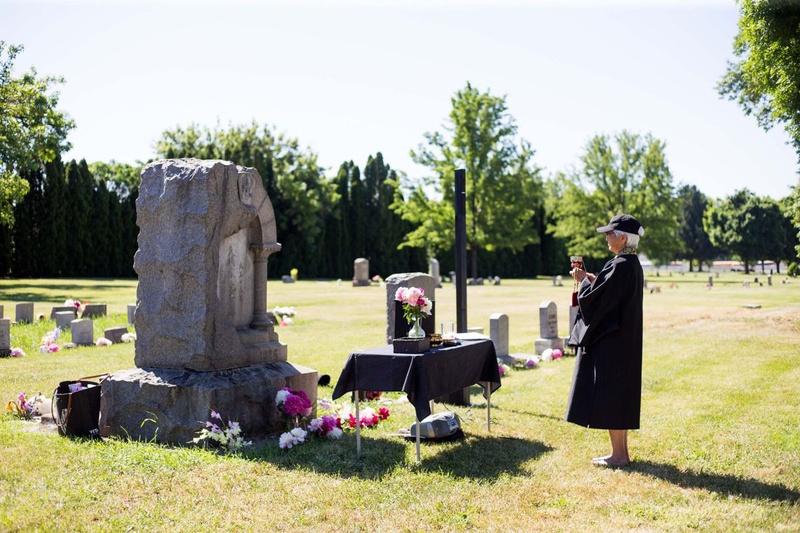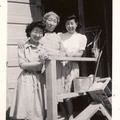Irene Goto stood in the sunlight at Tahoma Cemetery as members of the Yakima Valley’s Japanese-American community gathered near the graves of their ancestors.
“We are forever striving for permanence in the midst of what is transitory,” Goto, a minister’s assistant at the Seattle Buddhist Church, said Sunday morning.
Goto traveled to Yakima on Memorial Day weekend to continue a Japanese tradition that began in the Valley decades ago — that of placing peonies at ancestors’ graves and honoring them in a special service near their final resting places.
At 10 a.m. on the Sunday of Memorial Day weekend, an annual memorial service at Tahoma follows the placing of peonies at the headstones of those of Japanese ancestry.
After the service, some travel to the Lower Valley, where they place peonies at the headstones of their ancestors buried in Toppenish and Zillah.
“I bet you we decorate 500 graves,” said Lon Inaba, chairman of the cemetery committee. Nearly all of those graves are at Tahoma; they also decorate a few dozen graves in Toppenish and eight in Zillah, he said.
“Those are the ones that we know of,” Inaba added. “The only reason we know to decorate those graves is they were members of the community that we knew.”
Two sections of Tahoma contain the graves of the Japanese families who settled in the Yakima Valley, their descendants and their relatives. They lived and farmed in Toppenish and Wapato and worked in business districts they created in Wapato and Yakima before 1,017 Valley residents of Japanese ancestry were imprisoned at Heart Mountain Relocation Center in Wyoming in 1942.
Only about 10 percent of the Valley’s Japanese-American community returned to the area after World War II.
On Sunday, as church members and friends reconnected and remembered those they had lost, some also visited the third and newest section of Tahoma that will honor Japanese immigrants’ contributions to the communities of Eastern Washington.
With 200 plots for members and friends of the Valley’s Japanese community, the Japanese Pioneer Memorial Garden features two handmade torii (gates) standing inside a 40-foot circle. Looking through the West Torii from inside the circle, visitors see the oldest graves of the Japanese immigrants, known as Issei. Looking through the North Torii, they see the larger group of more recent Issei and Nisei (second generation) gravesites.
The garden will feature a teahouse and shrubs and trees common in Japanese gardens. It also will be decorated with fieldstones collected from various farm sites of Japanese pioneer families.
“There’s really not that many people left in the Japanese community, but we’ll have them,” Inaba said. “We’re not doing it for us; it’s for others down the road.”
Before Sunday’s service, Dave Sakamoto sat near the oldest graves of the Valley’s Japanese community, trimming the stems of dozens of peonies that had filled an apple bin in the back of Inaba’s pickup.
“I’ve been here since 8,” Sakamoto said around 9:30 a.m. He and other volunteers then put the flowers in square white buckets so people could carry them to each gravesite.
The first Japanese immigrants began arriving in the Yakima Valley in 1891, settling in the Lower Valley towns of Wapato and Toppenish and digging irrigation canals, clearing sagebrush and farming land they leased on the Yakama Reservation.
Three men — Thomas Oka, Naoki Masunaga and Manjiro Shinohara — came to Yakima in 1903 and purchased three blocks of land in Tahoma Cemetery to establish a Japanese public cemetery. They managed the cemetery and gravesites for the community and by 1904, eight people were buried there, according to an essay by Gail M. Nomura in “Nikkei in the Pacific Northwest: Japanese Americans and Japanese Canadians in the Twentieth Century.”
“The Japanese graves marked the permanent presence of Japanese in the Yakima Valley and the commitment of those who immigrated to remain in the Valley until their death,” Nomura noted in her essay titled “Becoming ‘Local’ Japanese: Issei Adaptive Strategies on the Yakama Indian Reservation, 1906-1923.”
Inaba is unsure if the men wanted to group all the Japanese graves together or if they were required to group them that way, but it makes it easier to decorate the graves, he said.
He joined the three-man cemetery committee — which also includes Mas Seto and Dean Hata — in 1996. And Inaba’s father was on the committee before him, he said while walking through the oldest grouping of Japanese graves. Two tall arborvitae trees stand next to those stones toward the southern portion of the cemetery.
“Ever since I was a kid, we would come and put flowers on the graves of family,” said Inaba, who is 60. That always followed a few weeks of collecting the flowers from several yards.
“Thanks everybody for attending and thank you for everyone who’s helped collect these peonies and grow these peonies,” Inaba said after the service. “They came from a lot of yards.”
Inaba’s great uncle was buried at Tahoma in 1913, among many other family members. And while many of the stones in the oldest section mark the graves of people who died anywhere from 1903 into the 1920s, a few are more recent.
“Somebody just got buried out here a little while ago,” Inaba said, pointing to the flat polished granite stone that marks the grave of Sue Y. Matsumura, who was born in 1917 and died in 2011.
Recorded music with words in Japanese played during the service as Goto said some of the words in English. “Thank you. That was a good attempt,” she said.
Goto stood near a folding table behind the large carved monument that marks the graves of Haruko and Frank Iseri, who owned a grocery store and farmed in Wapato. A small traveling altar, flowers and an incense burner rested on a black cloth covering the table.
About 30 people listened as Goto spoke of love, beauty, health and passion — what people treasure most in life — and death, pain, disease and sorrow, which no one can avoid.
Many had prayer beads around their left wrists or held prayer beads in their left hands.
“Shakyamuni Buddha is why we’re gathered here to honor our ancestors,” said Goto, who wore a black robe that reached just past her knees; a wagesa, which is a Buddhist stole; and a black ballcap emblazoned with the Wheel of the Dharma.
“This community is amazing, that you have carried on this tradition that began 2,500 years ago. We are here not because of our individual efforts, but because of the efforts of the ancestors before us,” Goto said.
“We realize that we are interdependent. When I see us all here together today, I see oneness.”
Brothers Tommy, Shig and Sam Uchida, who grew up in Wapato as three of six sons of Kaichiro “Harry” Uchida and Yoshiko Uchida, attended the services Sunday.
“My dad, when he immigrated to the U.S., he came to Seattle and then he went to mechanic school and opened up a shop” on West Wapato Road in Wapato that also served as a gas station, said Sam Uchida, who is 84. Tommy is 89 and Shig is 87.
Their youngest brother, Yosh, was born in 1943 at Heart Mountain and died in 2011.
“We’ve been trying to come once a year,” said Sam Uchida, who traveled with his wife, Masako, from Seattle for Sunday’s service. Tommy also lives in Seattle, while Shig lives in Kent.
Goto was pleased that they and others attended the memorial service.
“Thank you all for carrying on this rare, beautiful tradition. I hope it lives on,” she said.
*This article was originally published on Yakima Herald-Republic on May 29, 2017.
© 2017 Tammy Ayer






